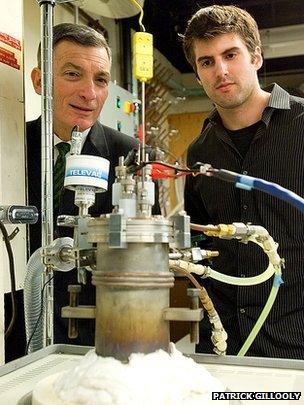Liquid metal promise for future batteries
- Published
Inside the Sadoway Lab's liquid metal battery workshop
Batteries have come a long way since Italian professor Alessandro Volta invented the first iteration some 200 years ago.
Even so, there are few candidate battery types that are suitable for storing energy on large scales - within an electrical power grid, for example.
Given that electricity is generally not stored, the grid has to carefully balance consumer demand for electricity with the amount being supplied by generators.
Grid-scale energy storage - sequestering electricity and then releasing it on demand - would be highly desirable. But any technology designed for such a purpose would have to deal with daunting amounts of power, be very cheap and have a long service lifetime.
Prof Donald Sadoway, from the Massachusetts Institute of Technology (MIT) in Cambridge, US, has been working on one technology designed to fulfil these requirements - liquid metal batteries.
The effort is now approaching a critical juncture. Sadoway has been working to scale up the technology through his company Ambri, external and is aiming for a commercial prototype to be ready by 2014.
"At least 18 months from now, we'll have something we can put in the hands of an independent assessor," Prof Sadoway told BBC News.
"We want to make sure we've got something that's durable and will perform to specification. This is a very tough market to get into.
"We can't afford to have a failure because something wasn't quite right. That could tarnish the image of the technology to the point where it would be set back irreparably."

Prof Sadoway (L) and graduate student David Bradwell observe an experimental battery in the lab
Most of the hurdles encountered during the scale-up are related to manufacturing issues; Donald Sadoway says the basic chemistry is scaling "beautifully".
A conventional dry-cell battery uses two electrodes separated by an electrolyte. But building a giant battery using dry-cell technology would require thousands of individual cells - about the size of a soft drinks can - to be strung together in a massive installation.
Prof Sadoway's concept relies on similar principles, but the key components are liquid. A molten-salt electrolyte is sandwiched between two liquid metal electrodes. A dense positive electrode lies at the bottom of the battery, while a low-density negative electrode floats atop the electrolyte. The difference in composition between the two liquid metals gives rise to a voltage.
The MIT electrochemist thinks it is possible to build giant batteries using 50-100 fewer individual cells this way than would be possible with a conventional battery array, reducing cost and complexity.
It's an idea that has attracted some $15m of investment from Bill Gates, Total and Khosla Ventures, run by Sun Microsystems co-founder Vinod Khosla.
The most basic version of the battery used magnesium for the top layer and antimony for the bottom layer. Prof Sadoway calls this iteration "generation zero".
The work on campus at MIT has since moved on: "We now have chemistries that we're calling fourth generation, fifth generation," Prof Sadoway explains.
Liquid metal batteries could find uses within a variety of electricity markets. One key area is that of bulk storage: storing energy generated in, for example, the early hours of the morning and then releasing it at peak periods during the day.
But they could also serve in "ancillary markets". One such area is keeping the mains power frequency "on-point". In most parts of the world, the frequency of the oscillations of alternating current (AC) is 50 Hertz (Hz), but in the Americas - including the US - it is 60Hz.
And it needs to be kept at these respective frequencies, plus or minus some fraction of a percent, or electronic devices can fail, for example.
A battery in the process of charging will appear on the grid as a load - meaning it consumes power from the grid. But it can also be used as a generator, which is how it appears to the grid when discharging.
"Judicious use of that in both load and generator modes can help regulate frequency," says Donald Sadoway.
Grid storage could be to help make renewables such as wind, wave and solar power competitive with traditional energy sources.
Wind speeds, and the amount of sunlight we receive, vary from day to day. As a result, the amount of power generated by these renewable sources fluctuates.
Currently, these fluctuations can be compensated for by adjusting traditional sources of energy such as coal and gas. But a convenient way to store the energy generated through wind and solar would allow them to supply power without being supplemented.
Sadoway's group has also looked at one model in which liquid metal batteries are installed in the basements of skyscrapers in Manhattan. Experts estimate that within three years, the ability to get electricity in Manhattan is going to be exceeded by demand from the island.
"If you have batteries, you could be taking electricity in the wee hours of the morning and then calling on it during the middle of the day," he explains.
"This is a term of art called transmission line deferral, where you can use existing transmission lines and not have to build more."

Batteries installed in the basements of Manhattan skyscrapers could solve a burgeoning electricity crunch
Peter Bruce, professor of chemistry at the University of St Andrews, UK, who is not involved with the MIT group, said: "Energy storage for the grid is going to be a very important problem in the future, because as we move towards increasing use of renewables or nuclear, it really does challenge grid stability and frequency regulation, for example."
"There's no one-size-fits all solution to storage on the grid, it's going to require different solutions because the size of the storage and the timescales you need to store them over are so vast... There is unlikely to be one technology that delivers everything."
In addition to liquid metal, other battery technologies for grid-scale storage include redox flow, lithium-ion and sodium-ion batteries.

The energy from renewables is variable, which is where storage technologies comes in
"They are all potentially important and interesting," says Prof Bruce, "I think it is still unclear which ones will win out.
"None of them are done deals with everything solved. At this stage it's a matter of trying to tackle the problems of each and see which ones will finally emerge as cost effective, reliable, robust, and deliver the performance."
Commercial sensitivities mean that the exact chemistry used in Ambri's versions of the battery remain secret.
"As a fledgling company, it's really important that too much not be disclosed because if some large entity decided that they wanted to enter this space, with huge resources, they could put scores of people on the problem and overtake us," the MIT professor explains.
"You're really vulnerable. You're like a little turtle on the beach, and at any moment a big bird could swoop down and pick you up off the sand before you get to the water."
But he adds: "Right now I think people are sceptical, and I'm happy with that."
- Published6 December 2012